A year ago, Sonny Gray had an ERA of 5.46, and although he had a 4.35 FIP and 4.25 xFIP, it seemed like absolutely nothing was working. Feeling the pressure to turn in good performances, it seemed like Gray was trying to change his game to see if he could get something to work, and when it didn’t, things got even worse.
Gray became probably the most hated player on the New York Yankees, as it became clear that he would never live up to the high expectations in his first full season with the team after being acquired in a big trade deadline swap with the Oakland Athletics in 2017. After a few more weeks of looking lost, his final start as a Yankee saw him get booed heavily as he exited the field after giving up seven runs in less than three innings. The Yankees bumped him from the rotation in early August, he was excluded from the ALDS roster and he was traded later that winter to the Cincinnati Reds.
2018 was the low point of Sonny Gray’s career, but you would never know it if you looked at his pitching line a year later. His 3.25 FIP would be his best since his rookie season in 2013 (when he only pitched 64 innings) and his 3.42 ERA would be his best since 2015. His 2.5 fWAR ranks 22nd among starting pitchers and sees him slightly trailing Justin Verlander (2.6 fWAR) and Chris Sale (2.7 fWAR) while being ahead of other big-name pitchers such as Trevor Bauer, Noah Syndergaard and his ex-teammate Masahiro Tanaka. Although he did not pitch, Gray was an All-Star and in his first start following the All-Star break, Gray survived Coors Field, striking out nine while only allowing one run in seven innings.
While predicting a bounce-back for Sonny Gray in 2019 as he got out of New York would not have been outlandish, I don’t think many would have predicted a season like this for Gray. With the Reds, Gray has been reunited with his college pitching coach from Vanderbilt, Derek Johnson, and that added level of comfort in addition to a number of improvements has led to Sonny Gray being an important cog in the Reds’ rotation, which has quietly been one of the best in the league.
Finding Your Slide
A quick look at Sonny Gray in 2019 will show a huge jump in his strikeout numbers. Indeed, Gray is striking out hitters at the highest rate of his career, with a 28.1% strikeout rate that easily trumps his previous high of 25.7% in 2013. But looking at Gray’s plate discipline profile in 2019 and comparing it to 2018, a lot actually looks the same:
| Year | K% | SwStr% | Chase% | Zone% | Z-Contact% | O-Swing% |
| 2018 | 21.1 | 10.1 | 26.2 | 46.4 | 86.4 | 29.0 |
| 2019 | 28.1 | 10.4 | 26.8 | 45.4 | 85.5 | 29.5 |
With such a high strikeout rate, we would expect there to be more swinging strikes, maybe more chases and maybe see hitters expanding the zone a bit more, but with Gray, most of these numbers are in line with his 2018 numbers. Something else must be happening outside of these metrics that are driving his comeback.
Sonny Gray has always had a good slider. Even last season it got good results, but those results were the weakest for the pitch by wOBA and xwOBA in his career. This season, though, the pitch is really taking off. In spring training this year, Gray was critical of how the Yankees were instructing him to use his slider. In short, he claimed they wanted him to throw the pitch for strikes in all counts, while Gray says that his slider is best when it is used to put hitters away. This may be a slight exaggeration, but it does appear that he was using the slider more when he was behind in the count in 2018 than he has in 2019. See for yourself—2018 is on the left, and 2019 is on the right:
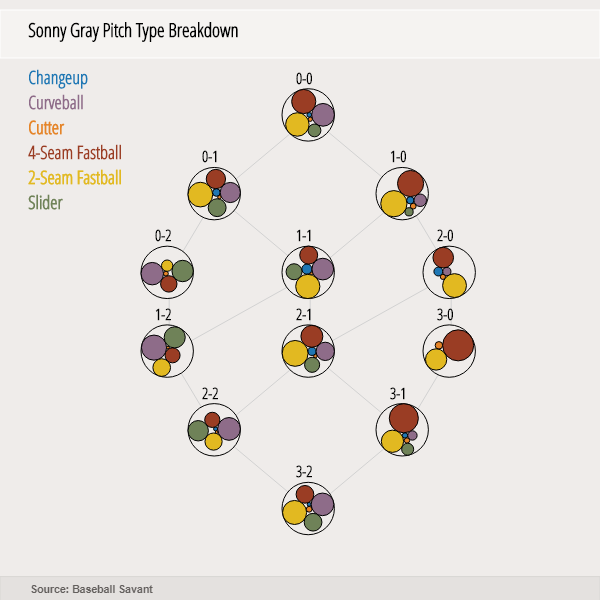
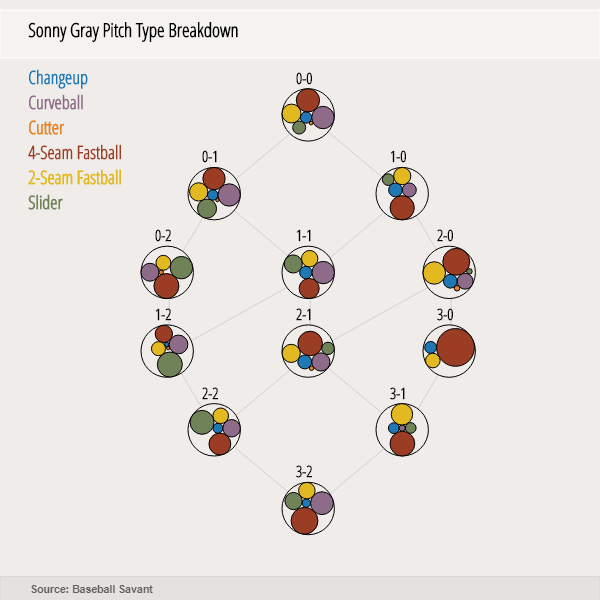
Gray appears to be right with his claim—he did throw the slider slightly more when he was behind or even in the count, most notably on 1-1 and 2-1 counts. Also, when Gray threw the slider when he was behind in the count, those pitches had a .406 wOBA against versus a .156 wOBA against when he threw it when he was ahead in the count. Again, it appears Gray is right in that he doesn’t have as much success trying to throw the slider for strikes in all counts as he does when he tries to get hitters to chase when he’s ahead. To see what it looks like when he’s using it how he likes, here’s Gray’s slider making Christian Yelich look foolish on a swinging strike three:
Looks awesome, right? With a change in his game plan, it looks like Gray has more confidence in the pitch, he’s using it the way he wants to and he’s getting the good results he expects with the pitch.
Tunnel Your Way to Success
Using the strong slider in a different way is only part of it, though. The pitch itself is also better. Gray’s slider is getting more horizontal movement on it this year than any previous year:
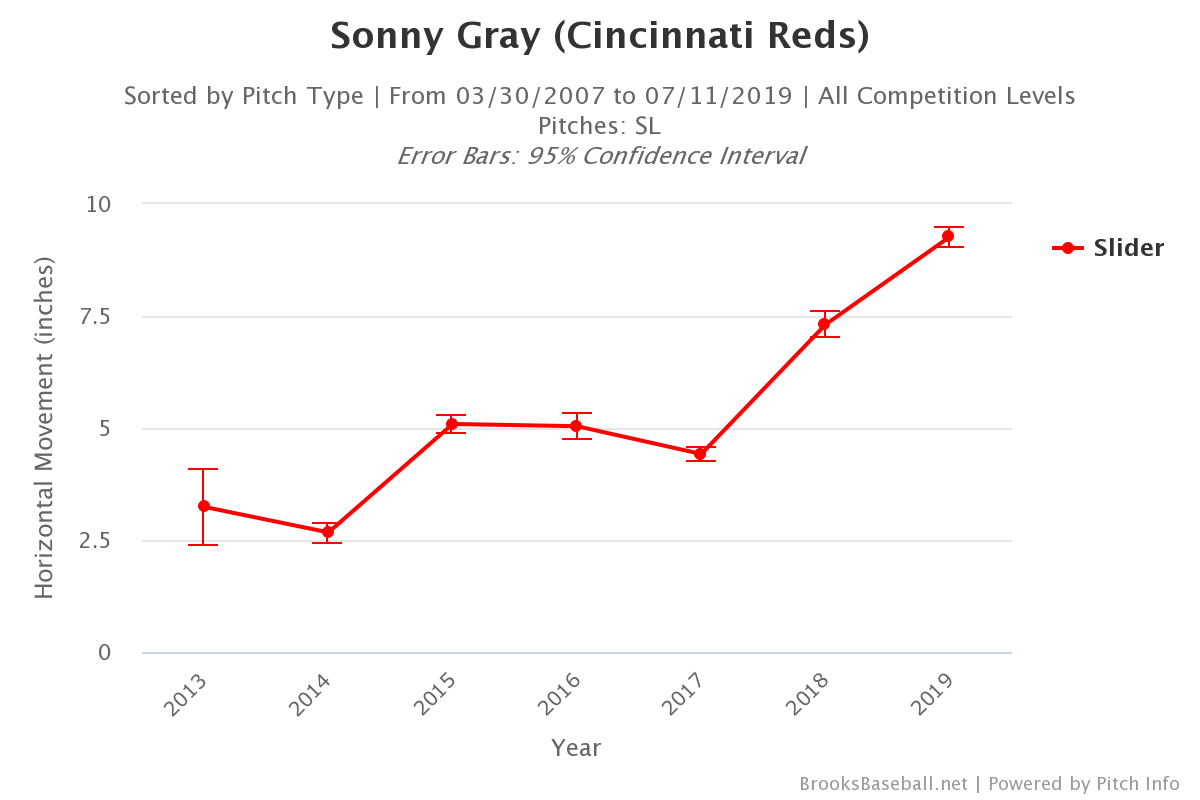
The improvement in horizontal movement is helping the slider catch-up to the curveball:
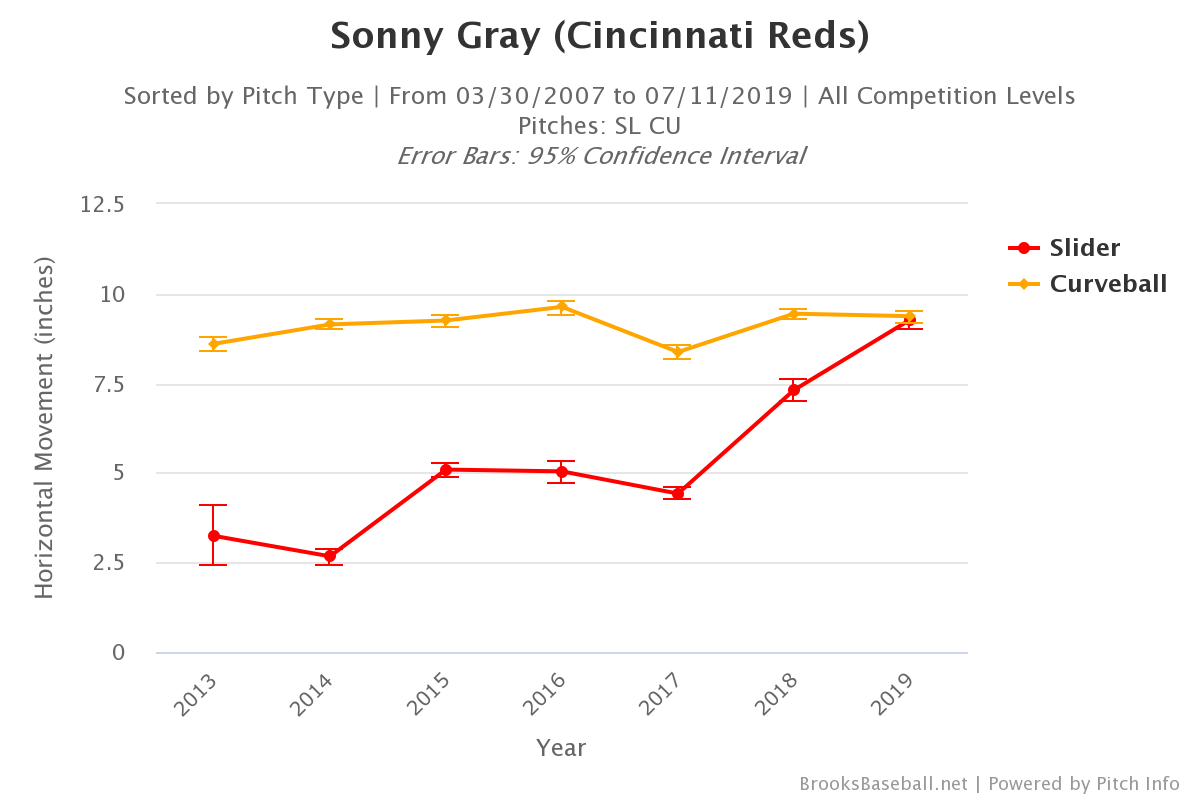
For the first time in Sonny Gray’s career, his slider is moving at the same level horizontally as his curveball. Gray’s curveball is also elite, with an only .209 wOBA against in 2019—among the best in baseball this season—so getting that slider to look more like his strong curveball seems like a good idea to me. It gets more interesting when you look at his horizontal release points from 2018 and 2019:
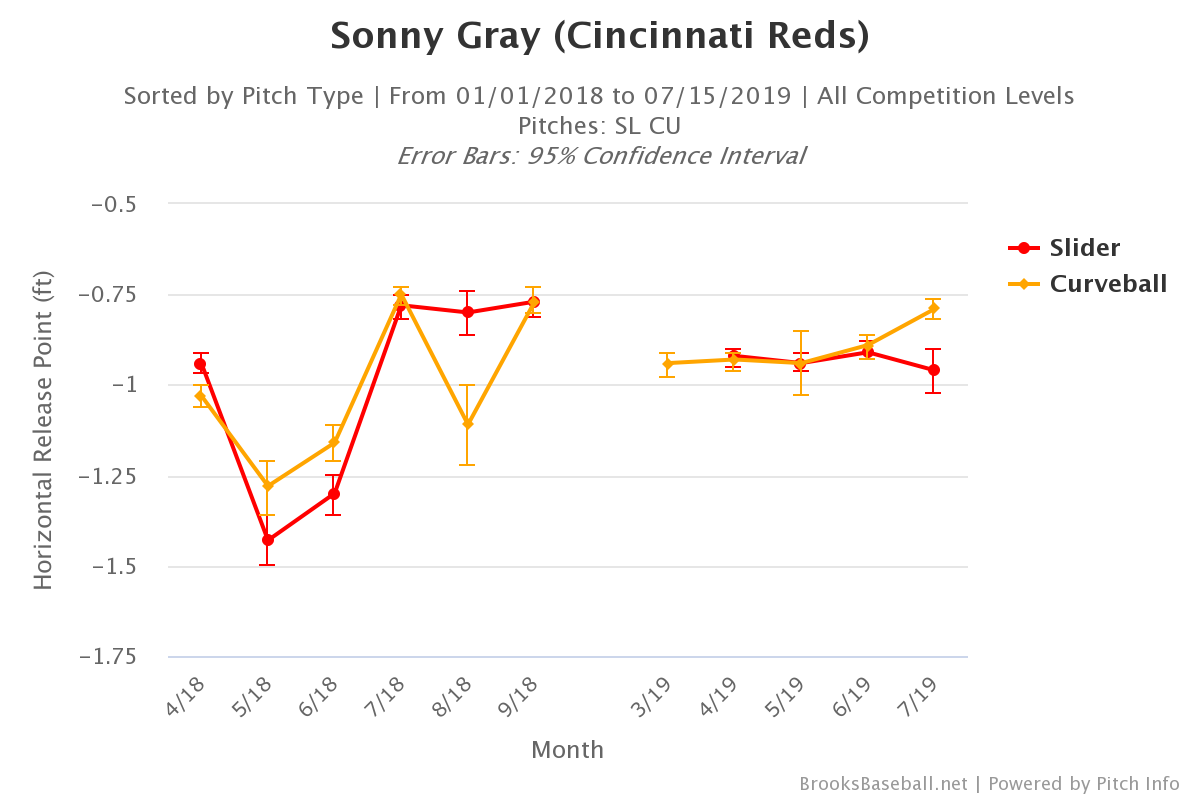
Ignore the diversion in July, as it is a very small sample of only eight sliders thrown in the entire month (and a start in Colorado to boot), but what I like best about this chart is the stability in his release points. In 2018, Gray’s release point seemed to never be consistent and while the release points seemed to move with each other from one month to the next, they were never really on top of each other like they have been in 2019. By stabilizing his release points on his curveball and slider, Gray gets his pitches to look more like each other. Combined with the movement improvement on his slider, batters cannot easily differentiate between his two best pitches, which results in more strikeouts. Here is Sonny Gray doing his thing with a curveball against Javier Baez and a slider against Max Muncy, both of which result in whiffs:
By getting his release points more in line with each other, Gray tunnels his pitches better, throwing hitters off and making hitting even more difficult than it already is.
Top of the Spindom
We know that Sonny Gray has changed his game plan with the slider and has improved his consistency in his release point to make the pitch look more like his curveball, but another area where Gray has improved this season is in the spin rates of his curveball and slider. Gray was already among the top spinners in the game on those pitches, but this year he has improved even more. While a slight improvement on an already high-spin curveball or slider might not make much of a difference, nor be the sole reason for a pitcher’s improvement, I do feel like it is important to mention.
Among pitchers who have thrown at least 750 pitches this season, Gray is 4th in average curveball spin at 2963 RPM and 10th in average slider spin at 2799 RPM and he is among the leaders in spin increases in both pitch types. Here are two graphs comparing him to the average. The first graph shows Gray’s spin rates compared to league averages and the second shows Gray’s spin differences also compared to the league average:
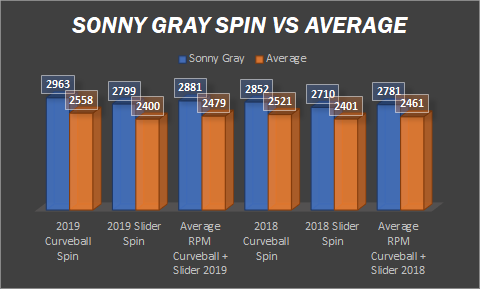
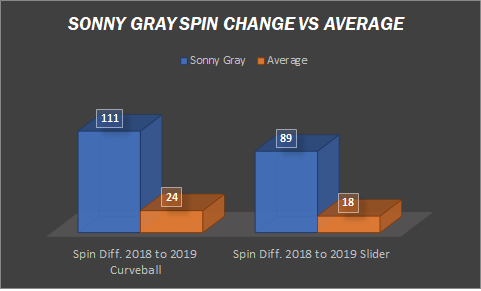
We see how much Gray stands out against the rest of the league. The spin he has added just this year is incredible—a whopping 111 RPM of spin on his curveball while the average pitcher has only added 24. Gray also ranks fifth among pitchers with the biggest gain in average RPM on both the curveball and slider, only trailing Jordan Lyles, Marcus Stroman, Dylan Bundy and Trevor Williams. What puts Gray on another level is that he still has a higher average RPM on both of those pitches than those with a bigger gain than him with a 2881 average RPM on his curveball and slider. The next closest pitcher among the biggest gainers is Marcus Stroman with a 2705 average RPM. That over 100 RPM difference shows that by improving on what was already a strength, Sonny Gray has been able to stand out even more when it comes to spin rate.
We knew that Sonny Gray was not as bad as he pitched in 2018. There was still a lot to like about his profile as a pitcher, and he may have been a little unlucky when looking at some of the more advanced statistics such as FIP, xFIP or SIERA. His struggles at Yankee Stadium in particular were something to behold, as his ERA was almost double when pitching at Yankee Stadium and it just looked like there was something going on mentally when he was pitching in New York.
If the Cincinnati Reds acquired the 2018 version of Sonny Gray they would have acquired a roughly league-average-ish pitcher and they would probably be happy about that. Instead, they have gotten a more confident version of Gray, who has been reunited with an old pitching coach and allowed more freedom with his pitching strategy. That alone is good, but remember that this version of Sonny Gray is also improving, as he is striking out hitters at the highest rate of his career and adding more movement and spin to an already elite slider and curveball. At the end of 2018, Sonny Gray’s best days could have been behind him, but he has run with his new opportunity and is better than ever.
Featured Image by Justin Paradis (@freshmeatcomm on Twitter)


Got him for $2 at auction, was kinda amazed.